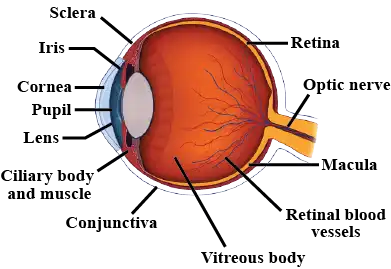Ans.
The human eye consists of several key components:
- Cornea: The eye is spherical and has a protective white layer. The front part of this layer is clear and called the cornea.
- Iris: Situated behind the cornea, the iris is a muscular structure responsible for the eye’s unique color.
- Pupil: The pupil is the small opening within the iris. The iris adjusts its size to control the amount of light entering the eye, and it’s through the pupil that light enters.
- Lens: The lens, located behind the iris, is thicker in the center and transparent. It focuses incoming light onto the back of the eye, known as the retina.
- Retina: The retina acts like a screen where images are formed. It contains photoreceptor cells called rods and cones, which convert light into electrical signals that are then transmitted to the brain through the optic nerve.
- Rods and Cones: These photoreceptors play a vital role in transducing visible light into neural signals, which are sent to the brain.
The process of image formation in the eye involves light entering through the pupil, passing through the lens, and getting focused on the retina. The image formed on the retina is real, inverted, and smaller. The optic nerve carries these visual signals to the brain, which interprets them, allowing us to perceive vision
